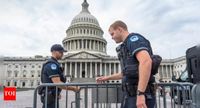With a government shutdown looming on the horizon, the White House has taken an unprecedented step: it has instructed federal agencies to prepare for the mass firing of employees whose jobs are funded by annual appropriations, should Congress fail to pass a funding bill by the September 30 deadline. This aggressive move, detailed in a memo from the Office of Management and Budget (OMB) sent on the night of September 24, 2025, marks a sharp escalation in the ongoing standoff between President Donald Trump’s administration and congressional Democrats.
Traditionally, federal shutdowns have involved furloughs—temporary, unpaid leaves—for so-called non-essential federal workers, with most returning to their jobs and receiving back pay once funding is restored. This time, however, the OMB’s memo signals a more permanent and disruptive approach. Agencies are being told to consider issuing reduction-in-force (RIF) notices, a federal term for layoffs, to employees in programs or projects that are not only running out of discretionary funds but are also "not consistent with the President's priorities." In other words, if a shutdown happens, some federal workers may not have jobs to return to even after the government reopens.
According to Politico, which first reported on the memo, this directive is a clear warning shot aimed at Senate Democrats as the clock ticks down to the start of the new fiscal year. The OMB memo states, "Programs that did not benefit from an infusion of mandatory appropriations will bear the brunt of a shutdown, and we must continue our planning efforts in the event Democrats decide to shut down the government." The memo further specifies that, once fiscal 2026 appropriations are enacted, agencies "should revise their RIFs as needed to retain the minimal number of employees necessary to carry out statutory functions."
The stakes are high. Congress has yet to pass a stopgap funding measure, known as a continuing resolution, to keep the government running past September 30. The House passed a clean seven-week extension on September 19, but Senate Democrats blocked it, demanding the renewal of expiring health insurance tax credits and the reversal of healthcare cuts enacted in the Republicans’ summer budget package. The GOP’s reconciliation package, meanwhile, has earmarked more than $150 billion for Pentagon military capabilities and over $170 billion for border security and immigration enforcement—priorities that would remain funded even during a shutdown.
In the memo, the OMB makes it clear that only programs benefiting from mandatory appropriations, such as Social Security, Medicare, veterans’ benefits, military operations, law enforcement, Immigration and Customs Enforcement, Customs and Border Protection, and air traffic control, would continue uninterrupted. All other activities are at risk. As CBS News reported, the memo bluntly states that "programs whose funding would lapse and which are otherwise unfunded... are no longer statutorily required to be carried out."
The Trump administration’s strategy has drawn fierce criticism from Democratic leaders. Senate Minority Leader Chuck Schumer blasted the memo as "an attempt at intimidation." In a statement late Wednesday, Schumer said, "Donald Trump has been firing federal workers since day one—not to govern, but to scare. This is nothing new and has nothing to do with funding the government." He predicted that "unnecessary firings will either be overturned in court or the administration will end up hiring the workers back."
House Minority Leader Hakeem Jeffries was even more direct in his response, posting on X: "We will not be intimidated by your threat to engage in mass firings. Get lost." He also labeled OMB Director Russ Vought a "malignant political hack." The memo, in turn, criticized congressional Democrats for refusing to support a clean funding bill, accusing them of partisan demands such as extending enhanced health insurance subsidies and reversing Medicaid cuts from the Republicans’ tax and spending law.
The White House insists that the steps outlined in the memo are a last resort. "We remain hopeful that Democrats in Congress will not trigger a shutdown and the steps outlined above will not be necessary," the memo reads. Nevertheless, the OMB has already held planning calls with federal agencies and requested updated shutdown plans by August 1, a sign that the administration is bracing for the worst.
President Trump himself has not shied away from confrontation. After initially agreeing to a weekend meeting with Democratic leaders Chuck Schumer and Hakeem Jeffries to discuss keeping the government open, Trump abruptly canceled, calling their demands "unserious and ridiculous." On Truth Social, he wrote, "I have decided that no meeting with their Congressional Leaders could possibly be productive." The OMB memo doubled down on this stance, describing Democrats’ position as "insane" and reiterating that core Trump Administration priorities would continue to be funded even in a shutdown.
This hardline approach did not emerge overnight. Back in February, Trump signed an executive order directing agencies to draw up plans for large-scale reductions in force—a move that saw mixed results across departments. Some agencies let go significant portions of their staff, others reversed layoffs, and a few even asked former employees to return. The current memo represents an extension of that strategy, now wielded as leverage in the high-stakes budget fight.
As the deadline approaches, the uncertainty is palpable across the federal workforce. According to Rachel Snyderman of the Bipartisan Policy Center, during the last major shutdown scare in March, more than 1.4 million employees were deemed essential and would have had to report to work, though many would not have been paid until funding was restored. Another nearly 900,000 workers would have been furloughed without pay. The current OMB directive, however, raises the specter of permanent job loss for many of those employees.
Federal unions and employee advocates have expressed alarm. The National Treasury Employees Union, representing a large swath of federal workers, said it had no knowledge of the memo, while the American Federation of Government Employees did not immediately respond to requests for comment. Bobby Kogan, a former OMB official during the Biden administration, called the potential mass firings "an action of enormous self-harm inflicted on the nation, needlessly ridding the country of talent and expertise." He added, "It’s also extortive. ‘Give us what we want in a funding fight, or we’ll hurt the country.’"
Meanwhile, the OMB has yet to post agency shutdown contingency plans online, a departure from previous practice that has left many in the dark about which functions and employees are deemed essential. The memo notes that "OMB has received many, but not all, of your submissions. Please send us your updated lapse plans ASAP."
The threat of mass layoffs has intensified the already fraught atmosphere in Washington. Democrats are holding firm on their demands for health care improvements and protection of federal subsidies, while Republicans and the Trump administration are insisting on a clean funding extension with no strings attached. With the government’s funding set to expire in less than a week, the possibility of a shutdown—and the unprecedented firing of federal workers—hangs over the nation like a storm cloud.
As the political brinkmanship continues, the livelihoods of hundreds of thousands of federal workers and the functioning of vital government services remain in the balance, awaiting a solution that seems, for now, frustratingly out of reach.

